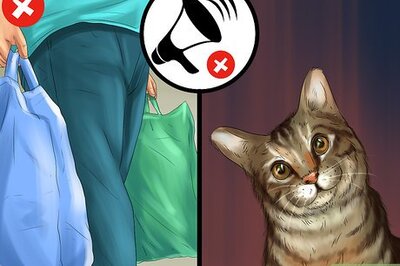
views
How to Handwash a Jellycat
For light messes, dab the Jellycat with a damp cloth and detergent. If your Jellycat just has a few light spots of dirt or grime on its fur, simply dampen a soft washcloth with lukewarm water. Apply a bit of gentle laundry detergent onto the dirty areas and gently dab them with the damp cloth. Just keep blotting the area until the dirt is all gone. If you don’t have laundry detergent on hand, DeCorte says dish soap can work in a pinch. Meet the wikiHow Experts Regina DeCorte is a residential cleaning specialist and founder of Maid in JC with over 8 years of experience. Claudia and Angelo Zimmermann are professional cleaners and the founders of Everneat, an Eco-Friendly Cleaning Service.
For heavy messes, soak the Jellycat in lukewarm water and detergent. If your Jellycat is very soiled, smells stinky, or simply needs a refresh, fill your sink or a basin with lukewarm water. Add a bit of gentle laundry detergent and submerge your plushie in the soapy water. Then, swish your stuffie through the water and use your hands to gently massage the dirty areas. Do not use hot water, as heat can damage your Jellycat’s fur and make it feel less soft.
Rinse the Jellycat with water until all of the soapy residue is gone. Run your Jellycat under lukewarm water to wash out the soapy water and all of the dirt you removed. Just keep it under the water until it runs clear and no bubbles appear. Then, very gently squeeze the plushie to get rid of the excess water. It’s important to rinse out all the soapy residue, as soap can leave behind a film that makes your plushie’s fur feel less soft. Do not twist or squeeze your Jellycat harshly, as this can damage it. Note: It’s completely normal for your Jellycat’s fur to feel rough or stiff while wet. Don’t worry—it’ll become soft again once you dry it and give it a comb! We’ll explain how to do that in the sections below.
How to Machine Wash a Jellycat
Check the label on the Jellycat to see if it’s machine washable. According to the Jellycat company, several plushies are safe to machine wash. Just check the care label sewn onto your plushie to see if it’s okay to throw in the machine, or if it’s handwash only. Or, search for your plushie on Jellycat’s website for safety and care instructions. Machine washing your Jellycat can be a more effective method than handwashing it, especially if your plushie needs to be disinfected or you need to remove strong odors. Note: Many Jellycat owners assert that handwash-only plushies are safe to wash in the machine as long as you follow Jellycat’s basic instructions. If you want to machine wash your plushie but it’s handwash only, just proceed at your own risk, as Jellycat doesn’t recommend this method for handwash-only products.
Place the Jellycat in a mesh bag or pillowcase to keep it safe. To protect your Jellycat from snags, tears, or other damage as it spins in the washing machine, the Zimmermanns recommend placing it in a mesh laundry bag. Or, if you don’t have a mesh bag, put it in a pillowcase and tie the end closed.
Wash the plushie on a cold, gentle cycle with a tiny bit of detergent. Set your washing machine to a gentle or delicate cycle and ensure the water temperature is set to cold. Then, add a tiny splash of gentle laundry detergent into your machine, place your Jellycat inside, and start the wash cycle. Wash your Jellycat in a separate load without any other clothes or towels in the machine. Other items can potentially damage your plushie. For extra deodorizing power, the Zimmermanns recommend adding 1 tbsp (15 ml) of distilled white vinegar to the rinse cycle. They say this also helps to remove the soapy residue. Jellycat says that you can wash your plushie in water up to 86°F (30°C), but cooler water is better to prevent potential heat damage.
How to Dry and Fluff a Jellycat
Pat your Jellycat dry and let it air dry by a fan or a window. Use a soft towel to gently pat your Jellycat and remove excess water. Then, Jellycat’s official recommendation is to leave it to air dry on a towel. For instance, set it in front of a fan blowing cool air or place it by an open window, says DeCorte. Or, clip it to your clothesline on a dry day. Let your Jellycat completely dry inside and out before giving it back to your child (or snuggling it yourself). If the inside stuffing doesn’t dry completely, it can start to smell or even develop mold and mildew. It may take 1 to 2 days for your Jellycat to completely dry. Keep your Jellycat out of direct sunlight as it dries, as harsh light can cause it to fade or damage the fabric.
Dry your Jellycat with a hair dryer set to cool as an alternative. While not an official Jellycat recommendation, many Jellycat owners prefer to dry their plushies with a hair dryer. Simply set your dryer to cool and select the highest airflow setting. Then, quickly move the dryer over your plushie so you’re not concentrating the air on a single spot for long. Keep the dryer about 1 to 2 inches (2.5-5 cm) above the plushie to prevent any damage, too. Keep drying the Jellycat until it’s completely dry to ensure the inside stuffing is no longer wet. This may take several minutes. Don’t forget to dry under your plushie’s neck, arms, tail, ears, and any other seams or creases, as these spots can retain moisture. Do not use your hair dryer’s highest heat option, as the heat can damage the fur and fabric. Feel free to let your Jellycat air dry a bit before hitting it with your hair dryer (or vice versa). Alternative option: Dry your Jellycat in the dryer with a few dry towels using your machine’s “No Heat” or “Air Dry” setting. While Jellycat does not recommend drying your plushie in the dryer, several people say they machine-dry their Jellycats with no issues. Try this method at your own risk.
Comb your Jellycat with a baby brush or toothbrush once dry. To fluff up your Jellycat, make its fur soft, and prevent any matting, give it a gentle brush. Simply comb a baby brush or clean toothbrush through its fur in the direction it lies. Just use short, gentle strokes until its fur feels nice and soft again.
How to Remove Stains from a Jellycat
Coat the stain with a laundry stain remover and then wash the Jellycat. Use your favorite laundry stain remover to treat any stubborn spots on your Jellycat. Just follow the directions for applying the specific stain remover you’re using and let it sit for several minutes. Then, hand or machine wash your plushie like normal.
How to Care for a Jellycat
Wash well-loved Jellycats about once per month. Like most plushies and stuffed animals, it’s recommended that you wash Jellycats that your child (or you!) cuddles and plays with about once per month. If your child sleeps with or chews on their Jellycat, though, you may want to clean it once per week. Of course, if you notice that your Jellycat is dirty or smells off, clean it as soon as possible. If your child (or you) is sick, make sure to wash your Jellycat once they're all better so it’s germ-free. If you have any Jellycats around for decoration, but you don’t actually play with them, you can go longer between washes.
Fluff and comb your Jellycat when you notice it looks worn. If your Jellycat starts to lose its shape or fluffiness, simply give it a little spa treatment. Shake it out to fluff up the stuffing and then gently pull and massage its limbs into shape. Then, use a baby brush or toothbrush to gently comb and soften its fur.
Store your Jellycats in a cool, dry place when not using them. If you’re putting up your Jellycat for a while, make sure to keep it in a cool, dry place so it doesn’t get damaged by heat or moisture. If you’re putting it in long-term storage, place it in a fabric bag so it doesn’t get dusty. Don’t place anything directly on top of your Jellycat while it's in storage, as it can become misshapen or damaged.



















Comments
0 comment